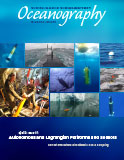First Paragraph
We are developing the “Micro-Rosette,” an instrument that will be deployed on an Argo-style profiling float. The Micro-Rosette is capable of capturing and storing a vertical profile of submilliliter seawater samples and then performing chemical analyses of the samples during a profiling float’s park cycle. The prototype Micro-Rosette was designed to measure dissolved inorganic carbon (DIC) based on the method of Hall and Aller (1992) and refined by Sayles and Eck (2009). This technique involves placing an acidified seawater sample in a gas diffusion manifold where the CO2 is quantitatively transferred to a receiving solution (NaOH). CO2 reacts with OH– to form carbonate and bicarbonate, thereby decreasing the solution’s conductivity. The carbonate-loaded NaOH is eluted through a custom capacitively coupled contactless conductivity detector (C4D), where the decrease in conductivity is quantified in order to determine the seawater’s initial DIC content.

